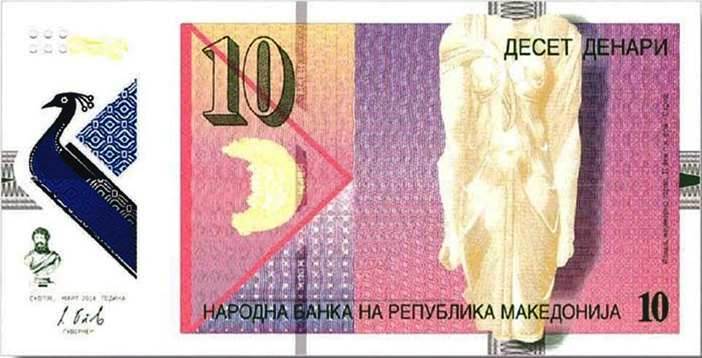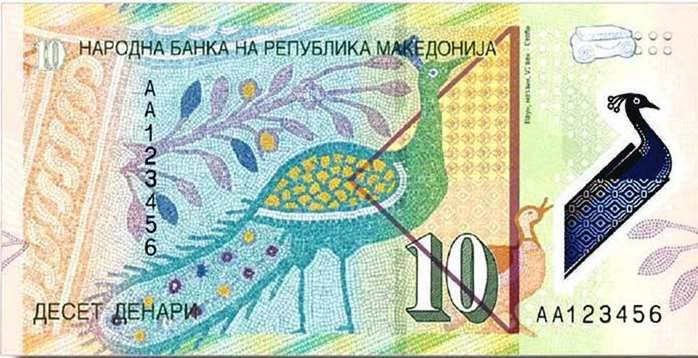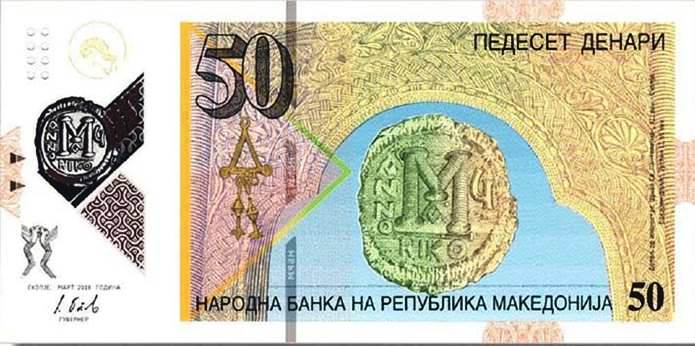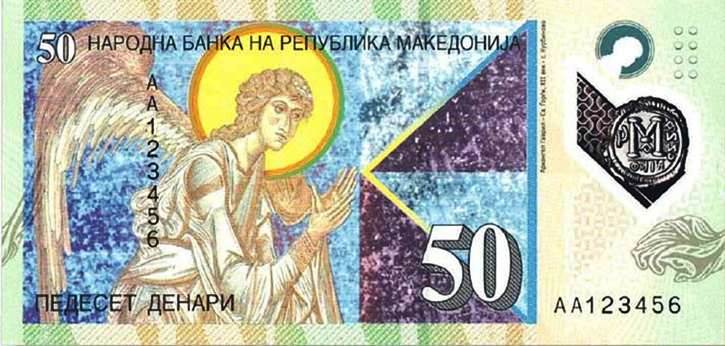Design of banknotes in denomination of 10 denars Dimensions: 126 mm х 63 mm Issue: 2018 Obverse 
On the front of the banknote, there is a presentation of a marble torso of the Egyptian goddess Isis (2 century BC), which was discovered in Ohrid, in one of the cult constructions dedicated to the goddess Isis. Isis was a goddess of fertility and motherhood, and was a protector of nature and magic. She was worshipped and respected even outside the borders of Egypt, even on the Macedonian soil, as witnessed by the numerous cult places, including the temple in the ancient town of Stobi, which is dedicated to her.
On the left half of the banknote, there is a presentation of a gold boat earring, dating back to the 4th century BC. It was discovered in a tomb of a young princess, found in the village of Beranci, Bitola, and is the best work of the then goldsmith's trade.
In the left upper part, there is a presentation of one part of ionic capital from the early 6th century, while in the left lower part, there is the marble bust of Titus Flavius Philoxenia (2nd century), a benefactor and high priest of the city of Heraclea Lyncestis (Bitola).
Reverse 
The peacock, the leitmotif of the back of the banknote, is a detail of the floor mosaic of the baptistery of the Episcopal Basilica in the ancient city of Stobi (4th - 5th century). This basilica is actually the oldest Christian temple in North Macedonia. Peacocks symbolize resurrection, immortality, and eternal life.
|
|
Design of banknotes in denomination of 50 denars Dimensions: 129 mm х 63 mm Issue: 2018
Obverse 
Leitmotif of the front of the banknote is a coin that was minted in the age of Justin II. Justin II succeeded to the Byzantine throne after the death of Justinian I in 565. His money is a frequent finding on the excavation sites in North Macedonia. The coin is framed in a decorative arch, which is taken from the church of St. Panteleimon (1164), village of Gorno Nerezi, Skopje and is one of the most beautiful examples of stone carving.
On the left half of the banknote, there is a presentation of a triangular bronze pendant, which dates back to the 7th-6th century BC, which was discovered on the excavation site Suva Reka - Paragon, Gevgelija.
In the left upper part of the banknote, there is a presentation of Archangel Gabriel, while in the left lower part, there are two intertwined winged serpents, a detail of a shallow carved double-wing door from the church of St. John the Baptist (16th century), village of Slepche, Demir Hisar.
Reverse 
On the back of the banknote, there is a presentation of Archangel Gabriel, a detail taken from the altar fresco Mother of God with Child on the throne, from the church of St. George (1911), village of Kurbinovo, Resen. The complete picture consists of a representation of the Mother of God on the throne with the playful Child in the hands. To the left of them, there is Archangel Gabriel, and to the right, Archangel Michael. The wall-painting in the church of St. George is a masterpiece of the Byzantine art of the Comneni in North Macedonia.
|